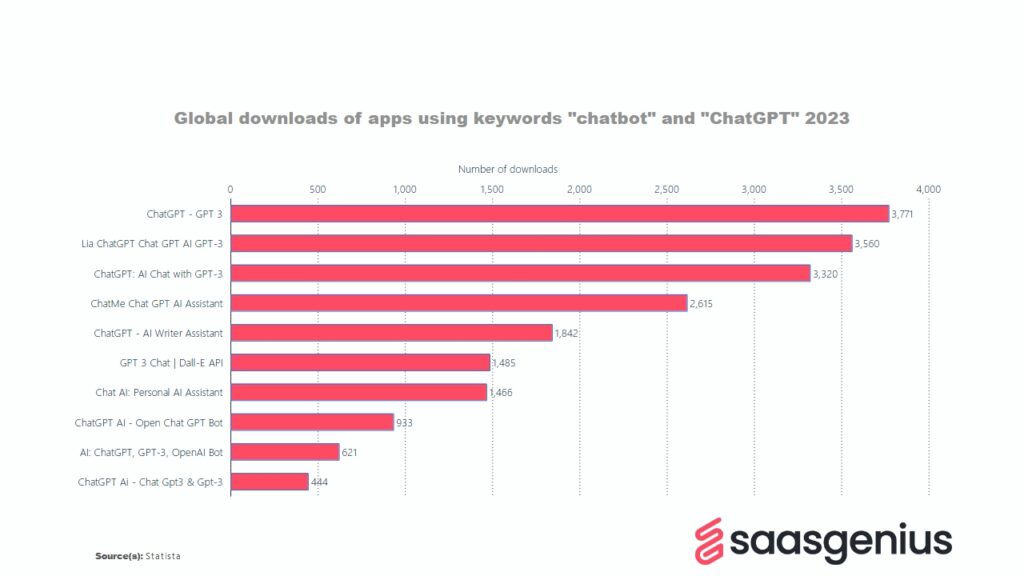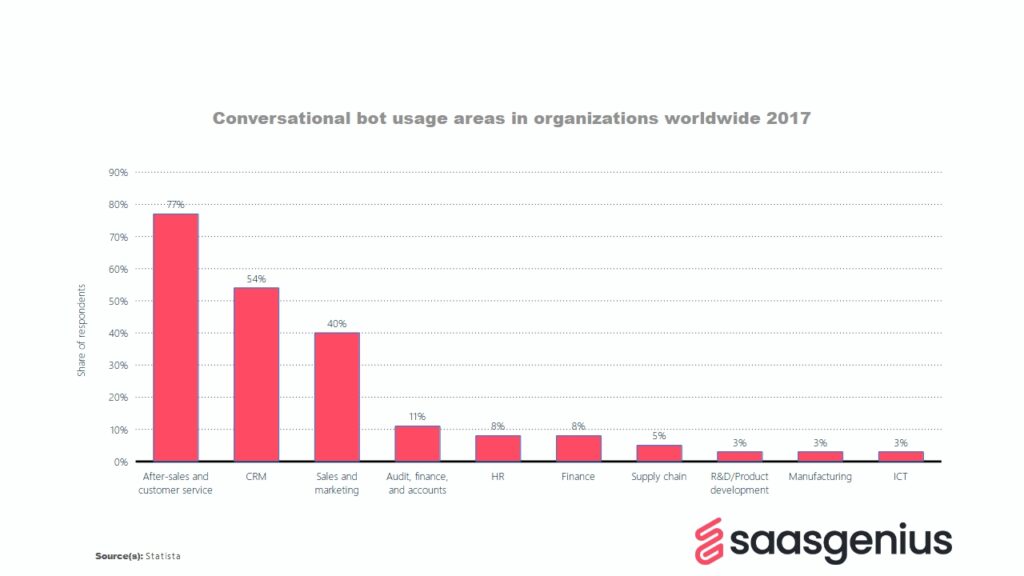ChatGPT and Chatbot Apps Downloads: Stats
Chatbots have been around for decades, but the rise in popularity of ChatGPT skyrocketed people’s interest in chatbot models and artificial intelligence in general. With the release of GPT-4, the latest language model by OpenAI, ChatGPT is able to take into account over 100 trillion parameters to provide you with an answer.
Obviously, there’s more to chatbots than getting them to do your coding homework or asking them a sassy question and seeing how the “robot brain” perceives our society. They feature in various industries and focus on process automation and optimization.
As expected, GPT dominates this category (chatbot downloads), with Chat AI being the odd one out.

Aside from ChatGPT, the top 10 apps using the GPT-3 technology by global consumer spend in 2023 are as follows:
- Genie – AI Chatbot
- AI Chat – Chatbot AI Assistant
- Pixelcut AI Photo Editor
- Open Chat Writer
- Apo – AI Personal Assistant
- Chat AI Bot Writing Assistant by AppTesun
- ChatOn
- AI Chat by tappz
- Chat AI by ElevenThirteenLLC
- GoatChat
Chatbot Statistics
According to expert projections, the global chatbot market size will grow sixfold from where it was in 2016. The company behind ChatGPT, OpenAI, projects to earn $1 billion in 2024, with most of the profits coming from the chatbot.
ChatGPT is not alone in this. According to Statista, aside from OpenAI, five additional companies managed to rake in over $100 million raised through funding. Check out the table to see the top AI startups in 2023 with regard to funding raised:
| # | AI Startup | Funding Raised |
|---|---|---|
| 1 | ASAPP | $380 million |
| 2 | Observe.ai | $214 million |
| 3 | Ada | $191 million |
| 4 | Cresta | $157.1 million |
| 5 | Woebot Health | $123.3 million |
| 6 | Forethought | $92 million |
| 7 | Kasisto | $81 million |
| 8 | PolyAI | $68 million |
| 9 | Balto | $52 million |
| 10 | Ushur | $42 million |
Interesting Facts
The most popular use of chatbots is for customer service automation. Customer support bots have been around for years, but AI conversational models have taken them several steps forward where the bot can solve some of the most common customer complaints on its own.

Today, one of the main aspects of support customers look for is instant response. If you want to improve customer retention and satisfaction, we can help you select the perfect live chat software for your business’s needs.
Aside from customer service, the main users of chatbots are CRM and marketing tools. Some of the most common uses of chatbots in marketing include the following:
- Targeted advertising
- Real-time content personalization
- Email marketing optimization
- Copywriting
- Calculating conversion probabilities
Another important influence chatbots have on B2B marketing is lead generation. Companies across the United States report that they’ve used a chatbot to help them increase their lead generation and get sales. According to a survey by Botco.ai, companies have varying experiences with chatbots’ effect on lead generation volume, as shown in the table below:
| Chatbots’ Percentage Increase in Lead Generation Volume | Percentage of Companies Surveyed |
|---|---|
| No impact | 3% |
| Less than 5% | 14% |
| 5–10% | 25% |
| 10–20% | 26% |
| 20–30% | 17% |
| More than 30% | 15% |
Conclusion
ChatGPT has been the talk of the (business) town ever since it became public. People have debated whether AI will cause job cuts or improve our lives without a byproduct.
Whichever way it goes, it’s certain that AI is here to stay, and chatbots are already an important part of how companies operate. Chatbots help with customer service, marketing efforts, various SaaS tools, and many other industries.
We’ve shown you what the most-downloaded chatbot and “ChatGPT” apps currently are, and you can look for ways how they can improve your business model.
Author
Methodology
- Who?
We are SaaS experts: Our specialists constantly seek the most relevant information to help support your SaaS business. - Why?
We are passionate about users accessing fair SaaS pricing: We offer up-to-date pricing data, reviews, new tools, blogs and research to help you make informed SaaS pricing decisions. - How?
With accurate information: Our website manager tests each software to add a Genius Score using our rating methodology to each product. Our editorial team fact-check every piece of content we publish, and we use first-hand testing, value metrics and leading market data.
